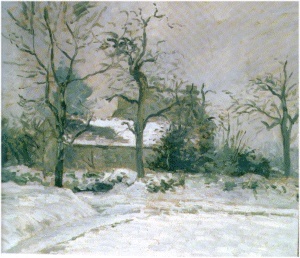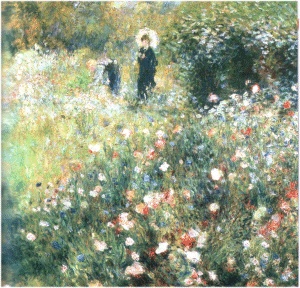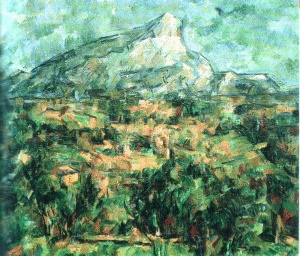
|

Landscape Impressions: (assignments at bottom)
 |
Impression: Sunrise, Claude Monet , 1872.
Impressionism takes its name from
this painting, one of the initial works exhibited by artists in Paris who were dubbed by critics, “painters of
mere impressions.”
On 15 April 1874 an independent art exhibtion opened at the former studio of the photographer Felix Nadar in Paris. The exhibition
was staged by a group of artists who called themselves the Societe Anonyme des Artistes, Peintres, Sculpteurs, Braveurs etc. and
was antagonistic against the despised regime of the Salon jury. 165 works were hung and a catalogue was put together by
Edmond Renoir, brother to the artist Pierre-Auguste Renoir (1841-1919). When Edmond criticized the uninspiring title of one
painting depicting a misty Le Havre harbour, the artist suggested he call it 'Impression, Sunrise'. The artist's name was Claude Monet.
It was this work that inadvertently gave rise to the label by which these artists and their paintings came to be associated.
The exhibition was given the title 'Exhibition of the Impressionists' and so the whole art movement got its name.
The sun in the painting is set against the dawn, the orange color against the gray and the vibrant force of the sun
against its motionless surroundings. It is nearly the same luminance as the grayish clouds.
An Impressionist paints landscapes and outdoor scenes outside, often working for a very short period of time. Then, as the light
changes, the Impressionist stops working, returning on a subsequent day when the light is similar. The Impressionist method
of working is made possible by new advances both by the packaging of colors in portable collapsible tubes, and because
of the new range of colors available. Impressionists were seen as artists who changed accepted concepts on color and light.
This is why they were mostly criticized by the traditionalist Salon jury.
|
 |
Piette's House at Montfoucault, Snow Effect, 1874 by Camille Pissarro.
One of Pissarro's closest friend was the wealthy and independent painter Ludovic Piette whom he had met in 1860.Piette lived on a farm in Montfoucault
in Brittany, and Pissarro would often visit him taking his large family with him. The picture of Piette's house in winter reflects
the artist experimenting with different techniques to capture the 'impression' of a cold winter's day and the translucent light
and almost eerie quiet that heavy snow in the early morning produces.
|
 |
Snow in Louvecienne by Alfred Sisley, 1878
Snow at Louveciennes also illustrates the painter's experiments with perspective: a snow-covered road disappears into
the background, inhabited only by one small, isolated character.
Sisley’s subject matter was largely limited to landscapes, in which only a few characters (like here a woman braving
the icy cold) may appear as decoration, many viewed his works as boring and lacking a personal touch.
The countryside in winter particularly attracted Sisley who excelled in capturing the sadness and desolation of nature.
Like Monet, Sisley followed Courbet's example in painting snow scenes. Through small touches of colour placed on the
canvas, the land appears iridescent (=schimmernd, schillernd) with bluish reflections rather than uniformly white.
Sisley's brushstrokes have become longer , more fluid and rhythmic in this painting than in earlier pictures.
Sisley had been able to admire the works of Bonington, Constable and Turner during the four years he spent in England
from 1857 to 1861, and on later visits.
|
 |
Woman with Parasol by Pierre-Auguste Renoir, 1875
French Impressionist painter, 1841-1919, Pierre-Auguste Renoir was an artist who was a leading painter in the
development of the Impressionist style.
In characteristic Impressionist style, Renoir suggested the details of a scene through freely brushed touches of color,
so that his figures softly merge with one another and their surroundings.
One of the best known Impressionist works is Renoir's 1876 'Dance at Le Moulin de la Galette'.
Renoir and Monet had at times worked alongside each other, and Monet's influence on Renoir at this point in his
career is quite evident in this painting. Renoir addressed this subject of carefree women appearing dwarfed amidst
a glorious natural background several times, but in general his works focussed more on the figures themselves
and on scenes of modern life rather than landscapes.
|
 |
La Montagne Sainte-Victoire by Paul Cezanne, c. 1906
The extent to which Cezanne was respected by a growing group of young artists wa reflected in a alrge painting by Maurice
Denis. 'Hommage a Cezanne' was exhibited in 1901, much to the delight of Cezanne. In his latter years Cezanne continued
to paint vigorously, walking into the countryside around his home and in particular painting Mont Sainte_Victoire - a favourite
subject.
The Sainte-Victoire mountain near Cézanne's home in Aix-en-Provence was one of his favourite subjects and he is known
to have painted it over 60 times. Cézanne was fascinated by the rugged architectural forms in the mountains of Provence
and painted the same scene from many different angles. He would use bold blocks of color to achieve a new spatial
effect known as 'flat-depth' to accommodate the unusual geological forms of the mountains.
This painting shows that Cezanne formed the bridge between late 19th century Impressionism and the early 20th century's
new line of artistic enquiry, paving the way for Cubism.
|
Assignments:
1. Where did the name 'impressionism' originate from?
2. Why would you associate Monet's painting 'Sunrise' with the style of impressionism?
3. What atmosphere do Pissarro's and Sisley's paintings arouse in you?
4. How is the woman depicted in Renoir's painting?
5. How does Cezanne's painting distinguish from the other ones?
|





